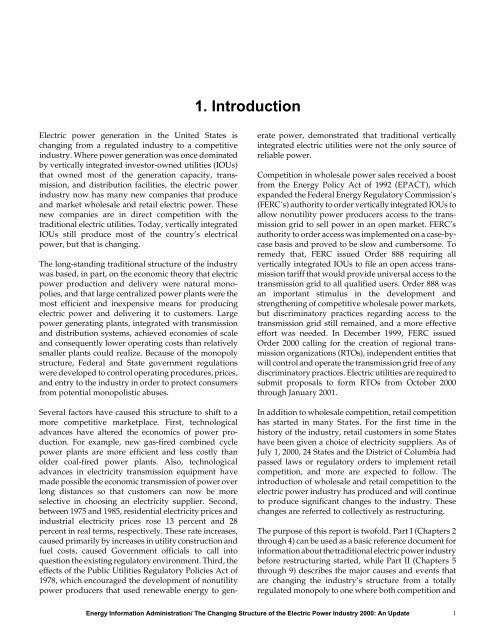The Changing Structure of the Electric Power Industry 2000: An ... - EIA
The Changing Structure of the Electric Power Industry 2000: An ... - EIA
The Changing Structure of the Electric Power Industry 2000: An ... - EIA
Create successful ePaper yourself
Turn your PDF publications into a flip-book with our unique Google optimized e-Paper software.
<strong>Electric</strong> power generation in <strong>the</strong> United States is<br />
changing from a regulated industry to a competitive<br />
industry. Where power generation was once dominated<br />
by vertically integrated investor-owned utilities (IOUs)<br />
that owned most <strong>of</strong> <strong>the</strong> generation capacity, transmission,<br />
and distribution facilities, <strong>the</strong> electric power<br />
industry now has many new companies that produce<br />
and market wholesale and retail electric power. <strong>The</strong>se<br />
new companies are in direct competition with <strong>the</strong><br />
traditional electric utilities. Today, vertically integrated<br />
IOUs still produce most <strong>of</strong> <strong>the</strong> country’s electrical<br />
power, but that is changing.<br />
<strong>The</strong> long-standing traditional structure <strong>of</strong> <strong>the</strong> industry<br />
was based, in part, on <strong>the</strong> economic <strong>the</strong>ory that electric<br />
power production and delivery were natural monopolies,<br />
and that large centralized power plants were <strong>the</strong><br />
most efficient and inexpensive means for producing<br />
electric power and delivering it to customers. Large<br />
power generating plants, integrated with transmission<br />
and distribution systems, achieved economies <strong>of</strong> scale<br />
and consequently lower operating costs than relatively<br />
smaller plants could realize. Because <strong>of</strong> <strong>the</strong> monopoly<br />
structure, Federal and State government regulations<br />
were developed to control operating procedures, prices,<br />
and entry to <strong>the</strong> industry in order to protect consumers<br />
from potential monopolistic abuses.<br />
Several factors have caused this structure to shift to a<br />
more competitive marketplace. First, technological<br />
advances have altered <strong>the</strong> economics <strong>of</strong> power production.<br />
For example, new gas-fired combined cycle<br />
power plants are more efficient and less costly than<br />
older coal-fired power plants. Also, technological<br />
advances in electricity transmission equipment have<br />
made possible <strong>the</strong> economic transmission <strong>of</strong> power over<br />
long distances so that customers can now be more<br />
selective in choosing an electricity supplier. Second,<br />
between 1975 and 1985, residential electricity prices and<br />
industrial electricity prices rose 13 percent and 28<br />
percent in real terms, respectively. <strong>The</strong>se rate increases,<br />
caused primarily by increases in utility construction and<br />
fuel costs, caused Government <strong>of</strong>ficials to call into<br />
question <strong>the</strong> existing regulatory environment. Third, <strong>the</strong><br />
effects <strong>of</strong> <strong>the</strong> Public Utilities Regulatory Policies Act <strong>of</strong><br />
1978, which encouraged <strong>the</strong> development <strong>of</strong> nonutility<br />
power producers that used renewable energy to gen-<br />
1. Introduction<br />
erate power, demonstrated that traditional vertically<br />
integrated electric utilities were not <strong>the</strong> only source <strong>of</strong><br />
reliable power.<br />
Competition in wholesale power sales received a boost<br />
from <strong>the</strong> Energy Policy Act <strong>of</strong> 1992 (EPACT), which<br />
expanded <strong>the</strong> Federal Energy Regulatory Commission’s<br />
(FERC’s) authority to order vertically integrated IOUs to<br />
allow nonutility power producers access to <strong>the</strong> transmission<br />
grid to sell power in an open market. FERC’s<br />
authority to order access was implemented on a case-bycase<br />
basis and proved to be slow and cumbersome. To<br />
remedy that, FERC issued Order 888 requiring all<br />
vertically integrated IOUs to file an open access transmission<br />
tariff that would provide universal access to <strong>the</strong><br />
transmission grid to all qualified users. Order 888 was<br />
an important stimulus in <strong>the</strong> development and<br />
streng<strong>the</strong>ning <strong>of</strong> competitive wholesale power markets,<br />
but discriminatory practices regarding access to <strong>the</strong><br />
transmission grid still remained, and a more effective<br />
effort was needed. In December 1999, FERC issued<br />
Order <strong>2000</strong> calling for <strong>the</strong> creation <strong>of</strong> regional transmission<br />
organizations (RTOs), independent entities that<br />
will control and operate <strong>the</strong> transmission grid free <strong>of</strong> any<br />
discriminatory practices. <strong>Electric</strong> utilities are required to<br />
submit proposals to form RTOs from October <strong>2000</strong><br />
through January 2001.<br />
In addition to wholesale competition, retail competition<br />
has started in many States. For <strong>the</strong> first time in <strong>the</strong><br />
history <strong>of</strong> <strong>the</strong> industry, retail customers in some States<br />
have been given a choice <strong>of</strong> electricity suppliers. As <strong>of</strong><br />
July 1, <strong>2000</strong>, 24 States and <strong>the</strong> District <strong>of</strong> Columbia had<br />
passed laws or regulatory orders to implement retail<br />
competition, and more are expected to follow. <strong>The</strong><br />
introduction <strong>of</strong> wholesale and retail competition to <strong>the</strong><br />
electric power industry has produced and will continue<br />
to produce significant changes to <strong>the</strong> industry. <strong>The</strong>se<br />
changes are referred to collectively as restructuring.<br />
<strong>The</strong> purpose <strong>of</strong> this report is tw<strong>of</strong>old. Part I (Chapters 2<br />
through 4) can be used as a basic reference document for<br />
information about <strong>the</strong> traditional electric power industry<br />
before restructuring started, while Part II (Chapters 5<br />
through 9) describes <strong>the</strong> major causes and events that<br />
are changing <strong>the</strong> industry’s structure from a totally<br />
regulated monopoly to one where both competition and<br />
Energy Information Administration/ <strong>The</strong> <strong>Changing</strong> <strong>Structure</strong> <strong>of</strong> <strong>the</strong> <strong>Electric</strong> <strong>Power</strong> <strong>Industry</strong> <strong>2000</strong>: <strong>An</strong> Update 1

















